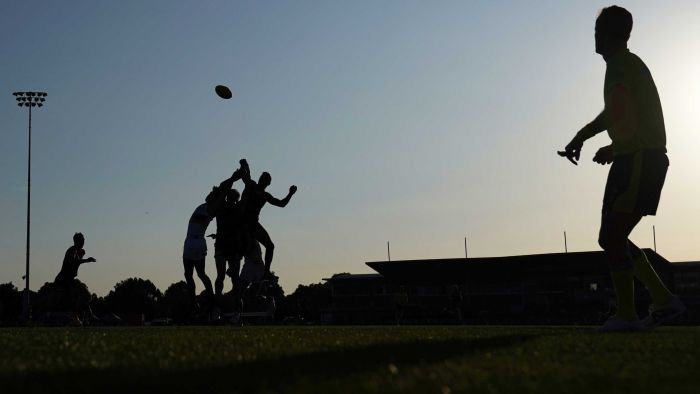A sports doctor says a national database of football-related deaths could help to prevent tragedies in the future.
Key points:
- A historic study has found 295 fatalities occurred from football injuries over the past 146 years
- Brain injuries were the most common causes of death
- More fatalities occurred in regional areas
Jacob Jewson of the Melbourne Football Club did a study of fatalities in Australian codes over 146 years.
He found there had been 295 deaths resulting from injuries sustained in soccer, rugby union, rugby league and Australian rules incidents over that period.
Dr Jewson compiled the data from archived media reports and said there had been 295 deaths resulting from injuries in football, rugby union, rugby league and Australian Rules over that time.
“There was quite a big spike in the 1930s with causes of death including brain injuries, abdominal injuries and spinal cord injuries,” he said.
Dr Jewson said brain injuries were the most common cause of death, accounting for 128 of the 295 fatalities, followed by abdominal injuries (74) and spinal cord injuries (28).
Other categories included deaths related to heat stroke, chest trauma and lightning strike.
Dr Jewson said nine deaths occurred between 2010 and 2018.
“This is probably reflective of the unpredictable nature of a lot of those injuries, the difficulty in treating them and protective equipment having little effect on severe impacts,” he said.
Call for US-style system
Dr Jewson said it would be beneficial if Australia had a national database of sporting-related deaths like those in the United States.
“We captured as much information as we could looking at the media reports, however we may not have captured everything,” he said.
“I think having an actual database documenting exactly what happened would help better inform – whether it’s the governing bodies of the codes or the government itself – on what’s happening in the community and what needs to be done to prevent further tragedies.”
Dr Jewson’s research showed that more than half of the fatalities occurred outside metropolitan centres.
“This was interesting to see when you consider the population in cities,” he said.
He said the challenges accessing health care and emergency services after catastrophic injuries were potential reasons for the higher figures.




Can more be done?
Dr Jewson said further steps could be taken to improve player safety.
“I grew up watching a lot of footy and as a fan you always grumble when rules change,” he said.
“But, as a medical professional, we need to keep the health of the players in mind.
“In every code, when you see players banned for dangerous tackles or hits, that sends the message that it shouldn’t be done, so I think that could still go further.
“Some of the commentary around head injuries are still very much, ‘You should be able to push through it’ — but I think the leagues are doing whatever they can to try and mitigate that risk.”




Sarah Chalmers, president of the Australian College of Rural and Remote Medicine and rugby union volunteer, said attitudes were changing at the grassroots level.
“Rugby union has done a huge campaign in identification of head injuries and concussion which is educating every level of player,” Dr Chalmers said.
“From the professional players, coaches, support staff, medical officers, right down to community levels like mums and dads taking up coaching.”
Problems have arisen for remote communities when guidelines call for imaging, according to Australian Medical Association Council of Rural Doctors chair Marco Giuseppin.
“We have excellent access to retrieval services to help facilitate this wherever in Australia you may find yourself, however the need to do so displaces a person from their community,” he said.
Australian Medical Association ACT president Antonio Di Dio said
“All of our members – particularly in the Rural Doctors Association cohort – are really concerned about access to imaging in remote areas,” he said.







